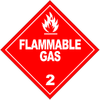The HAZMAT Class 2 in United States law includes all gases which are compressed and stored for transportation. Class 2 has three divisions: Flammable (also called combustible), Non-Flammable/Non-Poisonous, and Poisonous.
Divisions[]
Division 2.1: Flammable Gas
454 kg (1001 lb) of any material which is a gas at 20 °C (68 °F) or less and 101.3 kPa (14.7 psi) of pressure (a material which has a boiling point of 20 °C (68 °F) or less at 101.3 kPa (14.7 psi)) which-
- Is ignitable at 101.3 kPa (14.7 psi) when in a mixture of 13 percent or less by volume with air; or
- Has a flammable range at 101.3 kPa (14.7 psi) with air of at least 12 percent regardless of the lower limit.
Except for aerosols, the limits specified in paragraphs (a)(1) and (a)(2) of this section shall be determined at 101.3 kPa (14.7 psi) of pressure and a temperature of 20 °C (68 °F) in accordance with ASTM E681-85, Standard Test Method for Concentration Limits of Flammability of Chemicals or other equivalent method approved by the Associate Administrator for Hazardous Materials Safety. The flammability of aerosols is determined by the tests specified in 49CFR 173.306(i).
Division 2.2: Non-Flammable, Non-Poisonous Gas
This division includes compressed gas, liquefied gas, pressurized cryogenic gas, compressed gas in solution, asphyxiant gas and oxidizing gas. A non-flammable, nonpoisonous compressed gas (Division 2.2) means any material (or mixture) which:
- Exerts in the packaging an absolute pressure of 280 kPa (40.6 psia) or greater at 20 °C (68 °F), and
- Does not meet the definition of Division 2.1 or 2.3.
Division 2.2: Oxygen
This is an optional placard to the 2.2 Non-flammable Gas placard for compressed Oxygen in either the gas or liquid state. Oxygen is considered a non-flammable because it in and of itself does not burn. It is, however, required for combustion to take place. High concentrations of oxygen greatly increases the rate and intensity of combustion.
Division 2.3: Poison Gas
Gas poisonous by inhalation means a material which is a gas at 20 °C or less and a pressure of 101.3 kPa (a material which has a boiling point of 20 °C or less at 101.3kPa (14.7 psi)) and which:
- Is known to be so toxic to humans as to pose a hazard to health during transportation, or
- In the absence of adequate data on human toxicity, is presumed to be toxic to humans because when tested on laboratory animals it has an LC50 value of not more than 5000 ml/m³. See 49CFR 173.116(a) for assignment of Hazard Zones A, B, C or D. LC50 values for values for mixtures may be determined using the formula in 49 CFR 173.133(b)(1)(i)
Placards[]
Compatibility table[]
| Load and Segregation Chart | ||||||||||||||||||||||
|---|---|---|---|---|---|---|---|---|---|---|---|---|---|---|---|---|---|---|---|---|---|---|
| Weight | 1.1 | 1.2 | 1.3 | 1.4 | 1.5 | 1.6 | 2.1 | 2.2 | 2.2 | 2.3 | 3 | 4.1 | 4.2 | 4.3 | 5.1 | 5.2 | 6.1 | 7 | 8 | |||
| A | B | A | ||||||||||||||||||||
| 2.1 | 1001 lb | X | X | X | O | X | X | O | O | O | ||||||||||||
| 2.2 | 1001 lb | B | X | X | X | O | ||||||||||||||||
| 2.2 | 1001 lb | B | X | X | X | O | ||||||||||||||||
| 2.3A | any qty | X | X | X | O | X | X | X | X | X | X | X | X | X | ||||||||
| 2.3B | any qty | X | X | X | O | X | O | O | O | O | O | O | O | |||||||||
| Key | ||||||||||||||||||||||
The absence of any hazard class or division or a blank space in the table indicates that no restrictions apply.
| ||||||||||||||||||||||
References[]
- 49 CFR 173.115 (a) (U.S. Code)
- 49 CFR 173.115 (b) (U.S. Code)
- 49 CFR 177.848 (U.S. Code)




